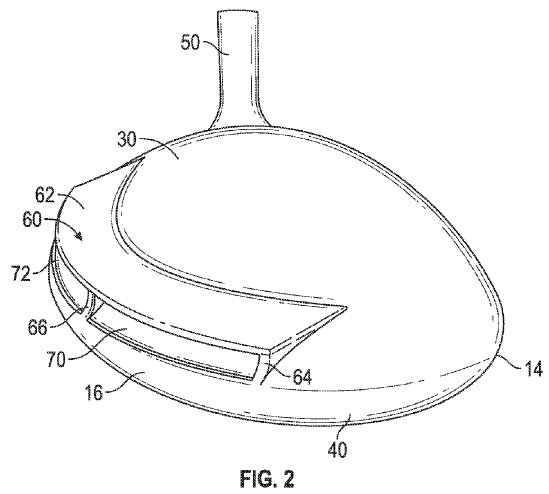Callaway Golf Spoiler Alert; Seriously, A Spoiler Alert!
Could this design be a next generation OptiForce driver, or is it simply a dream that will never leave R&D?
True golf geeks know that spoilers, fins, and wings are nothing new (just check out these posts, exhibit a, exhibit b, and exhibit c).
The drawings come from USPN 8,753,224, which was recently awarded to Callaway Golf after a pendency of only 16.5 months (kudos to the patent office). The patent describes the invention as:
A golf club head comprising a body having a crown, a sole, a face component, a heel side, a toe side, and a rear side, and an air spoiler affixed to the rear side of the body is disclosed herein. In particular, the air spoiler comprises an upper shelf that extends outwards from the crown and approximately parallel to a ground plane, and is supported by one or more ribs that extend perpendicularly from the upper shelf towards the crown. The air spoiler may be used in connection with any type of golf club head, and particularly a wood-type golf club such as a driver or fairway wood.
The patent goes on to explain:
The present invention relates to a golf club head comprising a spoiler 60 that reduces drag and increases the club’s swing speed. This feature may be used with any type of golf club head, and particularly a hybrid or wood-type golf club head such as a driver. This feature may also be combined with other aerodynamic features in a golf club, such as those disclosed in U.S. patent application Ser. No. 13/023,233, U.S. patent application Ser. No. 13/166,578, U.S. Pat. No. 8,241,142, and U.S. Pat. No. 8,317,636, the disclosure of each of which is hereby incorporated by reference in its entirety herein.
A preferred embodiment of the present invention is shown in FIGS. 1-6. In this embodiment, a driver-type golf club head 10 comprises a face component 20, a crown 30, and a sole 40 delineating a hollow interior, and also includes a heel side 12, a toe side 14, a rear side 16, and a hosel 50. A spoiler 60 is affixed to the rear side 16 of the golf club head 10, and comprises an upper shelf 62 and three ribs 64, 66, 68 extending perpendicularly downwards from the upper shelf 62 and connecting with the crown 30 near the junction where the crown 30 merges with the sole 40.
As shown in the Figures, the upper shelf 62 of the spoiler 60 is affixed to the crown 30 so that it smoothly blends into the crown 30 and extends outwardly, and approximately parallel with the ground plane 80, towards the rear side 16 of the golf club head 10. The ribs 64, 66, 68 provide support for the upper shelf 62 and create gaps 70, 72 between the upper shelf 62 and the crown 30, thus reducing the weight of the spoiler 60 and the overall weight of the golf club head 10. The upper shelf 62 of the spoiler 60 preferably has a thickness of 0.001-0.100 inch, while the ribs 64, 66, 68 preferably each have a thickness of 0.001-0.050 inch. The spoiler 60 preferably has an overall mass of no more than 20 grams, and more preferably between 10 and 15 grams.
As shown in FIG. 7, a low pressure zone forms behind a traditional, driver-type golf club head when it is swung, and causes significant drag that slows down the overall swing speed. The spoiler 60 shrinks the low pressure zone, reduces the drag created when air flows over the crown 30 and sole 40 during a swing, and thus increases the swing speed and stability of the golf club head 10 during a swing. Computational Fluid Dynamics (CFD) analysis has shown that as the airflow moves from the face 20 onto the crown 30 and sole 40 surfaces of the club head 10, it may accelerate and can promote negative drag on the transitional surfaces. This desirable negative drag can be achieved by including the spoiler 60 described herein.
I bet this design actually does make it to the market!
Dave Dawsey – The Golf Patent Lawyer @GolfPatents
PS – If you like what we are doing, please considering helping us out and make your online gear purchases through our Amazon affiliate link. Every little purchase helps us keep the site up and running! Thanks.

